#Turkish han
Text
Exploring the Dalmatian coast - Maškovića han revisited
Exploring the Dalmatian coast – Maškovića han revisited
It’s been seven years since we first visited Lake Vrana and explored the area around it. At that time, we saw the Maškovića Han from the outside, a 17th century project for a retirement home with guest rooms attached that was never completed. Over time, some of the more easily portable materials were snaffled to be reused elsewhere, but the overall walls and structure remained. There was a notice…
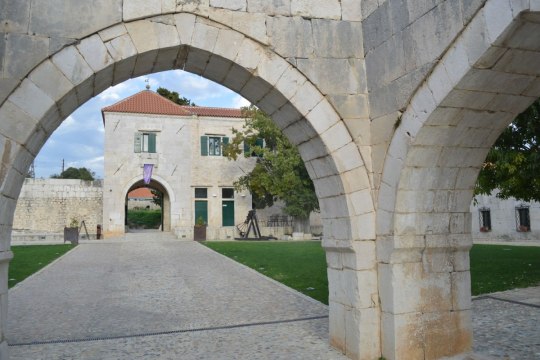
View On WordPress
#Croatian coast#culture#Dalmatian coast#history#Lake Vrana#Maškovića Han#Ottoman#outdoors#Travel#Turkish architecture#Turkish han
0 notes
Text



Bride of the Earth, Yılmaz Güney, 1968
11 notes
·
View notes
Text

Super Street Fighter 4 promo art by Hiroaki.
#SSF4#Street fighter 4 series#SF4#street fighter franchise#Street fighter 4#Unknown origin characters#M.Bison#Hiroaki#official art#Promo art#American character#Crimson Viper#C.Viper#Chinese character#Chun-Li#Japanese character#Ryu#Ken Masters#South Korean character#Juri Han#Turkish character#Hakan
9 notes
·
View notes
Text
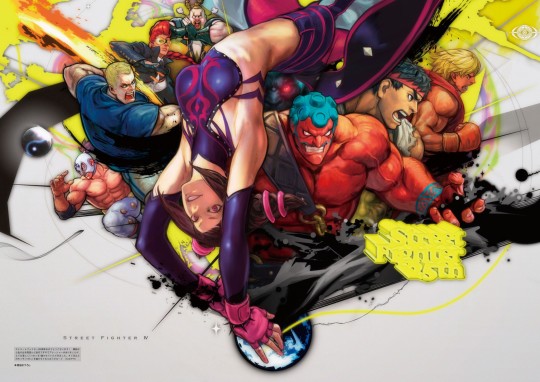
#Hiroaki#Official art#Hiroaki's artwork for UDON's SF25: The Art of Street Fighter artbook.#Turkish#Japanese#South Korean#French/Unknown origins#American#Ken Masters#Juri Han#Ryu (Street Fighter series)#Rufus#C.Viper#Mexican#El Fuerte#Hakan
20 notes
·
View notes
Photo

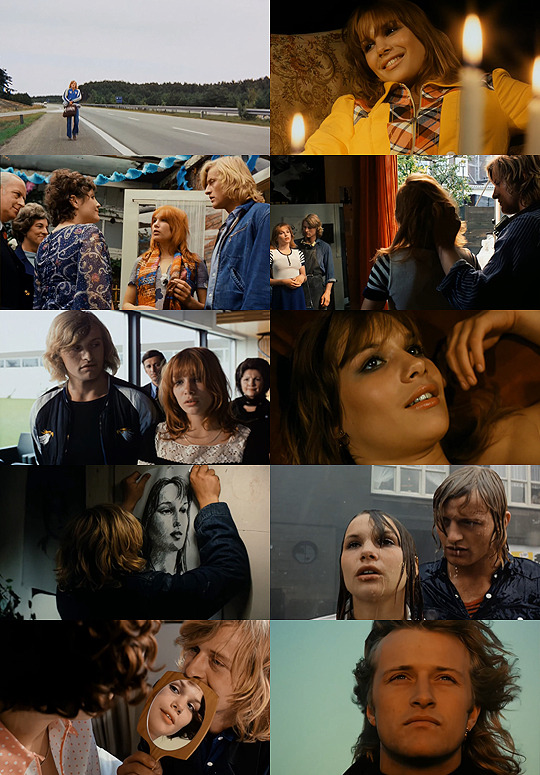
Films Watched in 2023:
20. Turks Fruit/Turkish Delight (1973) - Dir. Paul Verhoeven
#Turks Fruit#Turkish Delight#Paul Verhoeven#Rutger Hauer#Monique van de Ven#Tonny Huurdeman#Wim van den Brink#Hans Bonskamp#Films Watched in 2023#My Edits#My Post
25 notes
·
View notes
Text
youtube
turkish delight?
#turkey#ramen#noodle#the ramen rater#noodles#theramenrater#food#hans lienesch#soup#instant noodles#instant#thanksgiving dinner#parade#thanksgiving#thanksgiving day#grocery store#turkish#foreign languages#russian#unconscious#male whump#language learning#Youtube
5 notes
·
View notes
Text
This Green Costume is worn on Burak Özçivit as Malkocoglu Bali Bey in Magnificent Century Season 3 Episode 38 (2013) and worn again on Kadir Dogulu as Mehmet Giray Han in Magnificent Century: Kösem Season 2 Episode 26 (2017)


#recycled costumes#magnificent century#muhteşem yüzyıl#magnificent century kösem#Muhteşem Yüzyıl: Kösem#bali bey#mehmet giray han#period drama#historical drama#costume drama#reused costume#reused costumes#perioddramasource#perioddramaedit#dramasource#period dramas#turkish series
0 notes
Text
i think it should be a federal crime that my school does not teach ottoman turkish to my class specifically.
#only because we're the class that got taken into highschool through the entering exam!#i don't want focus on numerical lessons i want to learn ottoman turkish and expand my vocabulary and appreciate how language evolves and -#- feel upset over what aspects we lost of such a rich language due to modernization and assimilation.#also they should also be teaching us gokturkish. plain and simple‚ methinks#the fact that i see recognizable words in gokturkish in the orhun inscriptions is beautiful and i want to learn it. please#i want to read those extremely exaggerated epics about oğuz kağan but it's actually about mete han. in it's original language#and also more history please. two lessons a week is torture i cannot stand it i need to learn more in an academic setting#also more literature but that's irrelevant.#🌙rambling#actually no‚ it's not that irrelevant!#the orhun inscriptions are literature and the epics are literature and the legends are literature and we get to see so much history in it!#everything is interconnected etc etc. you understand
1 note
·
View note
Text
— Absentee Empires: The Absence of Ottoman Influence in the Grishaverse and Its Potential Depth and Complexity
@aleksanderscult @siriuslyobsessedwithfiction @stromuprisahat @black-rose-writings Please share your thoughts on this—I’d love to hear your opinions!
One aspect of the Grishaverse that truly frustrates me is the absence of a nation inspired by the Ottoman Empire and the Arab world.
We have six well-defined nations—Ravka influenced by Imperial Russia, Fjerda drawing from Scandinavia, Shu Han reflecting elements of China and Mongolia, Kerch resembling the Netherlands, Novyi Zem based on the Americas, and the Wandering Isle inspired by Celtic cultures. But somehow, there’s no representation of the Ottoman Empire? It feels like a significant oversight, especially considering the empire's substantial power during the 16th century and its enduring influence into the 18th and 19th centuries, even amidst its decline.
While the Grishaverse hints at other “colonies” beyond the main nations, that doesn’t quite make up for the lack of an Ottoman-inspired culture. Just think about the richness it could have added! An Ottoman-inspired nation could have been filled with intricate politics, vibrant culture, and a fascinating history of diplomacy—especially with Ravka as a neighbor. The Ottomans had a complex and often contentious relationship with Imperial Russia, which included both trade and warfare. Imagining Ravka’s brooding intensity interacting with a nation influenced by Ottoman culture could have created such a thrilling dynamic, rich in both conflict and collaboration.
At first, I thought maybe some elements of Ottoman culture were reflected in Shu Han. But it’s pretty clear that Shu Han is primarily inspired by Mongolian and Chinese influences, making that connection a bit of a stretch. This feels like a missed opportunity, considering the Ottoman Empire was vast and influential, controlling significant parts of Southeast Europe, Western Asia, and North Africa. At its height, it was one of the world’s most powerful empires, playing a crucial role in European and Middle Eastern politics.
The potential for conflict between Ravka and an Ottoman-inspired nation would have been especially compelling. The 18th and 19th centuries saw numerous wars between the Ottoman Empire and Russia, primarily over territory in Eastern Europe and the Black Sea. These Russo-Turkish Wars significantly shaped the geopolitical landscape of the region. Instead of a straightforward narrative, we could have seen intricate power dynamics where alliances constantly shifted, leading to moments of both tension and unexpected cooperation. Imagine the political intrigue and skirmishes we could’ve witnessed…Instead of a simple “Good vs. Evil” narrative, we could have had layers of complexity, like “Who’s backstabbing whom today?” or “Are we trading grain or are we going to war?!”
But despite their military conflicts, the Ottoman Empire and Imperial Russia maintained a complex relationship that involved significant trade. As neighbors with intertwined economies, they exchanged goods like grain and textiles while competing for influence. A similar relationship in the Grishaverse could have added depth, showcasing how economic interdependence can exist alongside rivalry.
Additionally, the relationship between the Ottoman Empire and Fjerda could have been more diplomatic and friendly, especially given the historical context of increased interactions between the Ottomans and Scandinavian powers. The Danish and Swedish crowns sought to establish formal relations to protect their trade interests and gain support against regional rivals like Russia and Poland. For example, during the Great Northern War, Sweden sought support from the Ottomans against Russia. Although no significant military alliance was formed, the prospect of cooperation was explored. Diplomatic missions often resulted in the exchange of knowledge about military tactics, geography, and culture, enriching both sides’ understanding of each other. The relationship between the Ottoman Empire and Scandinavian countries was multifaceted, involving trade, diplomacy, and cultural exchange that could have deepened the tension between Ravka and the Ottoman-inspired nation. You know the saying, "the enemy of my enemy is my friend"? The Ottoman nation would have taken that to heart!
Finally, an Ottoman-inspired nation might have treated Grisha in a way that reflects the Ottoman Empire’s approach to its minorities, offering some autonomy under a millet-like system but with enough restrictions to keep everyone on their toes. You know, like “You can have your own laws, but only if you don’t annoy us.”
In conclusion, the absence of an Ottoman Empire or Arab-inspired nation in the Grishaverse represents a missed opportunity to enrich the narrative with the complex dynamics and vibrant cultures that characterized these historical realms. The interplay between an Ottoman-inspired nation and Ravka could have introduced captivating political intrigues, cultural exchanges, and historical rivalries that would elevate the storytelling. The rich history of the Ottoman Empire—its intricate relationships with neighboring powers, its approach to trade, and its treatment of minorities—offers a wealth of material that could have added depth and complexity to the Grishaverse.
Ultimately, incorporating such a nation could have not only enhanced the world-building but also provided a platform to explore themes of power, identity, and coexistence in a compelling way, making the Grishaverse an even more engaging and multifaceted universe.
Any comments or opinions are appreciated it !!!
#idk everytime I re-read the books#or even watch the show#I think of this#and the missed opportunities#grishaverse#grisha trilogy#shadow and bone#the crows#the darkling#nikolai lantsov#kaz brekker#ravka#fjerda#shu han#kerch#leigh bardugo#aleksander morozova#general kirigan#alina starkov#genya safin#grishaverse meta#ruin and rising#siege and storm
77 notes
·
View notes
Text
WHAT HAPPENED TO COUNTESS MARIA OF SALONA?
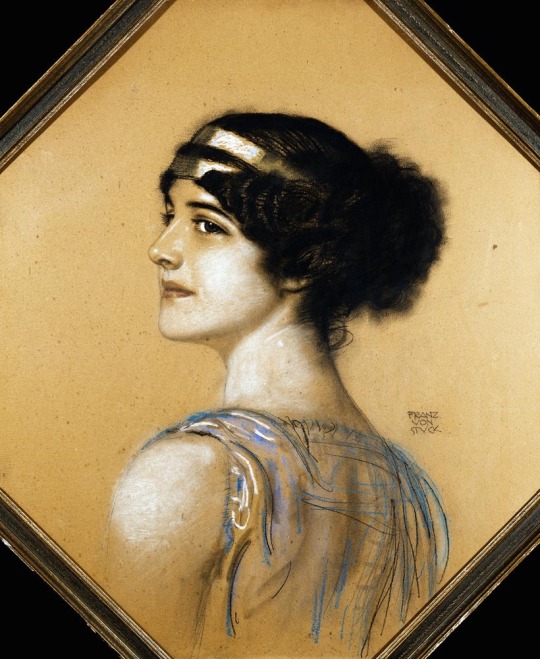
Maria Fadrique was born around 1370, the daughter of the last Catalan Count of Salona, Don Louis Fadrique, and his Greek wife, Princess Helena Fadrique, also known as Helena Kantakouzene or The Despina, Helena Asenina.
Not much information about her early childhood has been preserved. We do know that she grew up as an only child to the noble couple and was likely prepared and claimed as the only heir to the County of Salona.
In 1382, at the age of 12, she succeeded her father and became the Countess of Salona in her own right. However, due to her age, she was deemed too young to manage the county, so her mother, the Dowager Countess Helena Fadrique, took charge as regent. That same year, she was betrothed to Bernat Hug, a son of Felip Dalmau, but the betrothal was annulled.
Despite reaching the age of maturity in 1386, at 16, an age when she was now deemed fully capable of managing the County of Salona, her mother remained in power over all state affairs, and Maria had yet to step a toe into the world of politics. That same year, her mother betrothed her to a son of the Serbian Emperor Symeon Uros for political reasons, but this betrothal, like the first one was annulled. That same year, she was betrothed to an alienated associate of the King of Aragon, but the wedding never took place.
From the years of 1388-1391, Helena refused to repay damages to a Venetian citizen who suffered the loss of property aboard a ship from Ancona by her late husband, Don Luis Fadrique, in 1380. This made her mother very unpopular with Venice.
Her mother was quite hated by the people, who most likely would have preferred Maria to take charge over state affairs, but this never happened. Even at the age of 20, Maria had not taken charge over state affairs. This decision to keep the Dowager Countess in charge would eventually cause their deaths.
Though Necdet Sakaoğlu in his work “Bu Mülkün Kadın Sultanları” claims she was betrothed to Manuel II in 1393, I have not seen another source to confirm this claim.
In this same work, Sakaoğlu tells the story of the capture of Maria and her mother in late 1393 or early 1394. “Turkish soldiers captured the Frankish ship that was bringing Maria to Istanbul in the Dardanelles and captured its occupants.” - Necdet Sakaoğlu, “Bu Mülkün Kadın Sultanları,” pg 88.

Upon meeting the beautiful and affianced Countess, Sultan Yildirim Bayezid Han was smitten with her, and both the mother and the daughter were brought to his harem in Edirne, and Maria became his concubine, yet in other accounts he actually married her.
The Italian pilgrim Nicholas of Martoni, returning from Jerusalem by way of Greece in 1395, crossed the Gulf of Corinth from Vostitza (Aigion) to Vitrinitza in April. He was told that the district of Vitrinitza was then held by "the Grand Turk" who had acquired it from the lord of Salona ("Dominici de Sola") whose only daughter he had married. The Byzantine Family of Kantakouzenos (Cantacuzenus) Ca. 1100-1460: A Genealogical and Prosopographical, pg 163.
That same year in 1394, Helena died, but it is not clear if it was due to an execution or other reasons. According to Laonikos Chalkokondyles, the Countess Helena disgraced herself and brought shame upon the people of "Delphi" by committing her authority into the hands of her lover, a priest called Strateus, for which reason the Archbishop of Larissa denounced her to the Basileus (Sultan) and gave him the pretext for taking over the County of Salona. - The Byzantine Family of Kantakouzenos (Cantacuzenus) Ca. 1100-1460: A Genealogical and Prosopographical, pg 161.
As for Maria, she was executed a year later in 1395 after Bayezid allegedly found her unworthy of him, and eventually lost interest in her. However, this reason seems highly improbable.
When Bayezid lost interest in her, he wouldn’t have executed her but instead discarded her or even sent her away to the old palace in Bursa. The reason for her execution must be something else, either she was executed for political reasons or she went against the rules or even committed a crime, or even struck his ego in the wrong place. Nonetheless, it is highly unlikely for a Sultan to execute a concubine/wife of his because he lost interest in her.
( Sources: The Byzantine Family of Kantakouzenos (Cantacuzenus) Ca. 1100-1460: A Genealogical and Prosopographical, Necdet Sakaoğlu, “Bu Mülkün Kadın Sultanları".)
#geology#Hatun#royalife#BayezidI#Bayezid I#sultan bayezid#Bayezid The Thunderbolt#Bayezidthethunderbolt#Yildirim Bayezid#YildirimBayezid#Yıldırım Beyazıt#YıldırımBeyazıt#Assembly#Sultan Yildirim Bayezid Han#Countess Maria#Maria of Salona#Countess Maria of Salona#Helena Fadrique#ottoman empire#County of Salona#Aragon#Count Louis Fadrique#history#Helena Kantakouzene#Helena Asenina#concubine#osmanlı#Sultan#Imperial Harem#mariaofsalona
89 notes
·
View notes
Note
Now, I am from Turkey and I cannot speak for all Southwest Asian, North African and South Asian people out there, I can only speak of what I've spotted based on the info I have. But Radz-at-han def has some Turkish influence. The lamps on the bazaar are absolutely same with the ones in Grand Bazaar (Kapalıçarşı). There's meyhane! A win for Turkey Iran and Balkans! Also Akyaali (ak yalı in Turkish) means white beach literally. And not to forget Kapikulu. And the npc names: i have spotted fantasty versions of some turkish names. Oh and... Karniyarik is from Turkey (means belly splitted literally bc you split the belly of the eggplant). Thavnair itself does not look like Turkey at all fauna/flora/climate wise.
Tho South Asian influence is also very prominent in Radz-at-han/Thavnair. I think there's a good amount of Mughal Empire inspo there. But I don't have enough info to talk about it. I'll leave it to South Asian folks! I also think there's Farsi inspo. (Satrap is a title of ancient Persian empire). Like I said, feel free to correct me if i'm wrong!
For Ala Mhigo, I would say it has much SWANA influence overall. Especially Levant is very visible for me. Arak being Levantine spirit for example. And Sumerian Ziggurats. Also "ala" prefix/article.
I've spotted Turkish influence ( imambayıldi being a turkish food)(ala mhigan gown having anatolian kilim motifs)(conquest war against the neighboring nations in the past)(visual inspo from eastern, southeastern and inner anatolia for example: Cappadocia, salt lake area and salt industry. Travertines next to M Tribe and Travertines in Pamukkale. Tho Turkey is not the ONLY visual inspo for the region there are many many other SWANA inspos like i said, for exp: ziggurats).
Disclaimer: No matter how much inspo they have from the real world, Ala Mhigo and Radz-at-han are fictional. The inspos overlap a lot and most of the times they're not clear-cut. And sometimes they do not reflect the real world. I only mentioned of the things I've spotted. However, South Asia, Southwest Asia and North Africa are very diverse and beautiful regions with diverse cultures, civilizations and peoples and I don't have sufficient info to talk about it all so I am sure there are many things I've missed out on Ala Mhigo and Thavnair that my fellow SWANA people and South Asian folks can point out! Also both of these fictional countries have inspirations from other cultures as well (like ala mhigan monks). After all, Turkey is only a part of the inspiration both for Ala Mhigo and Thavnair. But it made me incredibly happy to see it. And i hope the real world inspirations in this game made the others happy as well!
(linking to my original post on this convo so i dont lose it again lmao)

thank you so much for your thoughts on this anon I really adore hearing about where people have seen their own cultures within the game! I think it's so super cool and im so glad you shared with me!
#ffxiv#i also love hearing about this stuff because im just#not super familiar with worldwide cultures and history aha#my area of knowledge is north american pre history#i can go on and on about clovis culture but uh thats about it aha#plus it makes me so happy when other people can go hey look that's me!!!#like knowing it made you super happy to see these influences in game makes me super happy too <33#i dunno i just love this stuff thank you so much for sharing!
51 notes
·
View notes
Text

Super Street Fighter IV: Promo art by Hiroaki.
#Hiroaki#Street fighter series#Street fighter 4 series#official promo art#Hakan#Turkish character#south korean character#Juri Han
4 notes
·
View notes
Note
realized I never sent in my ideas for the Disventure Camp characters’ last names… so here:
My last names for the cast + my headcanons: (i’ll be leaving some out bc i like their last name or their last name is strictly canon as in they’re called their last name basically every single episode)
Aiden Cadena ; i hc him as half latino half white
Ally Glitch
Alec Mustafa ; i hc him as half black half japanese half turkish
Connor Manfred ; i hc him as jewish/white
Ashley McGrawl
Dan Evans
Ellie Han ; i hc her as half asian half white
Drew Leblanc
Gabby Kowalska
Fiore Lombardi ; i hc her as a quarter asian 3/4s italian/white
Hunter Wang ; i hc him as half asian half white
Jake Sun ; I hc him as asian
Jeon Yul ; i hc him a quarter latino 3/4s asian
Karol Jones ; i hc her half black half white
Kai Cortez ; i hc him half latino half black half indigenous half asian
Maggy O’Connor
Lill Chow ; i hc her as half asian half white
Nick Burton — Idk if they still had Milton for Nick’s but if they did, Milton works for me too
Miriam Fletcher
Riya Varma
Oliver Navarro-Phan ; i hc him as half latino half asian half black
Tess Kurosawa ; I hc her as a quarter asian 3/4s white
Rosa Maria Hernandez
Tom Noi ; i hc him as half asian half white
Will Hemingway — last name just struck something in me. a polite & jumpy guy needs a polite last name
i WILL say that I think Derek Johnson is half asian half latino + Trevor McGregor is half asian half black
+ Kristal Mclean is 3/4s latina and a quarter asian bc I hc Chris Mclean as half white and half asian👍🏼
U don’t need to agree w my headcanons or last names, but i thought i would give my take on this💜
.
#disventure camp#disventure camp aiden#disventure camp ally#disventure camp alec#disventure camp connor#disventure camp ashley#disventure camp dan#disventure camp ellie#disventure camp drew#disventure camp gabby#disventure camp fiore#disventure camp hunter#disventure camp jake#disventure camp yul#disventure camp karol#disventure camp kai#disventure camp maggy#disventure camp lill#disventure camp nick#disventure camp miriam#disventure camp riya#disventure camp oliver#disventure camp tess#disventure camp rosa maria#disventure camp tom#disventure camp will#derek johnson#trevor mcgregor#kristal mclane
22 notes
·
View notes
Text
16th c. Costume Books, a Problematic Source for Dress History

But did they really dress like this?
Costume books and costume albums are a popular source for dress historians, historical costumers, and reenactors researching 16th and early 17th c. Europe. There are good reasons for this. They are primary source documents (at least sometimes), and they show the clothing of cultures and social groups that are difficult-to-impossible to find in other types of period art, like the Irish and rural peasants. Examples of these books include Trachtenbuch des Christoph Weiditz, Habiti antichi et moderni di tutto il Mondo di Cesare Vecellio, and Théâtre de tous les peuples et nations de la terre avec leurs habits et ornemens divers. These books are, however, deeply problematic as a dress history source for several reasons. In this post, I will discuss the ways they are problematic and how those of us researching historical dress can gain a better understanding of what the people shown in these books were actually wearing. I have broken down the problems with using these images into 4 areas.
Embodied biases:
The creators of these books were, at least sometimes, prejudiced against the cultures they were portraying, and these biases may have affected how they characterized these cultures. Hans Weigel, author of Habitus praecipuorum populorum, characterized his native German fashion as modest and virtuous and characterized elaborate Italian fashions as decadent and corrupt. Weigel considered these 'strange' foreign fashions a threat to the 'civilized' German fashion he favored (Bond 2018). This bias might have motivated Weigel to idealize his portrayal of German fashion or to exaggerate the strangeness of Italian fashion in order to scare his readers away from trying it.
Weigel's dislike of flashy foreign fashions seems mild in comparison to the bigotry of some of his peers. Flemish artist Lucas de Heere and French artist François Desprez both labeled the Scottish 'savages' in their books. Jost Amman's description of a purported Turkish sex worker in the German edition of Gynaeceum, sive Theatrum mulierum, is appallingly bigoted:
"A Turkish Wh*re: This is a prostitute, who sells her impure body for dirty money to a lover that pleases her. With the earnings of this sin she dresses herself prettily and beautifully, in order to attract the Turks even more easily with her false ornaments." (translation from Ilg 2004)
Considering the blatant bigotry he shows here, I wouldn't anything about trust Amman's depictions of sex workers, Turks, or any other non-Western Europeans. Or any other women, really.
Sights unseen:
Even when costume book creators weren't actively trying to perpetuate their biases through their work, their ignorance could still cause problems. These artists did not always visit the countries whose costumes they painted. They relied on other artists' work or even just verbal descriptions to fill in the gaps in their knowledge. The resulting images can distort the cut, construction, and material of the clothing.
For example, the Turkish women in this original woodcut by Pieter Coecke van Aelst are wearing shawls or scarves with long fringe wrapped around their heads and shoulders. In the Christoph von Sternsee costume album's illustration based off Coecke van Aelst's print, the fringed shawl has become a strange, tailored hood with a panel of pleated cloth attached to either it or the gown below.
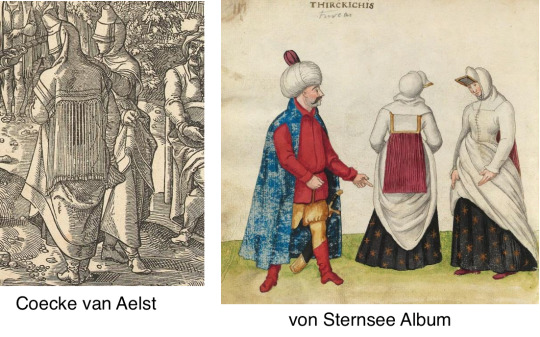
(Coecke van Aelst's woodcuts were identified as the source for the von Sternsee album's illustration in Katherine Bond's 2018 dissertation.)
Copy of a copy of what?
In spite of the problems it causes, copying from other artists' work was common in costume albums (Bond 2018). Considering that the artists did not visit all the cultures they illustrated, this is unsurprising. Some images were copied repeatedly, and the artist misunderstanding the source material wasn't the only source of distortion. Artists also made up details to compensate for bare-bones source material.
This simple line black-and-white print of an Irish woman wearing a léine (linen tunic), brat (Irish mantle), and headwear was used by several artists, all of whom made changes and additions. The first copy in this post is the most faithful to the original, but it still adds long sleeves and eyelet holes on the neckline to the léine. The coloring of the headwear suggests a wool hat crested with a tuft of horsehair and having a linen roll at the bottom. The coloring also gives the brat a contrasting lining.
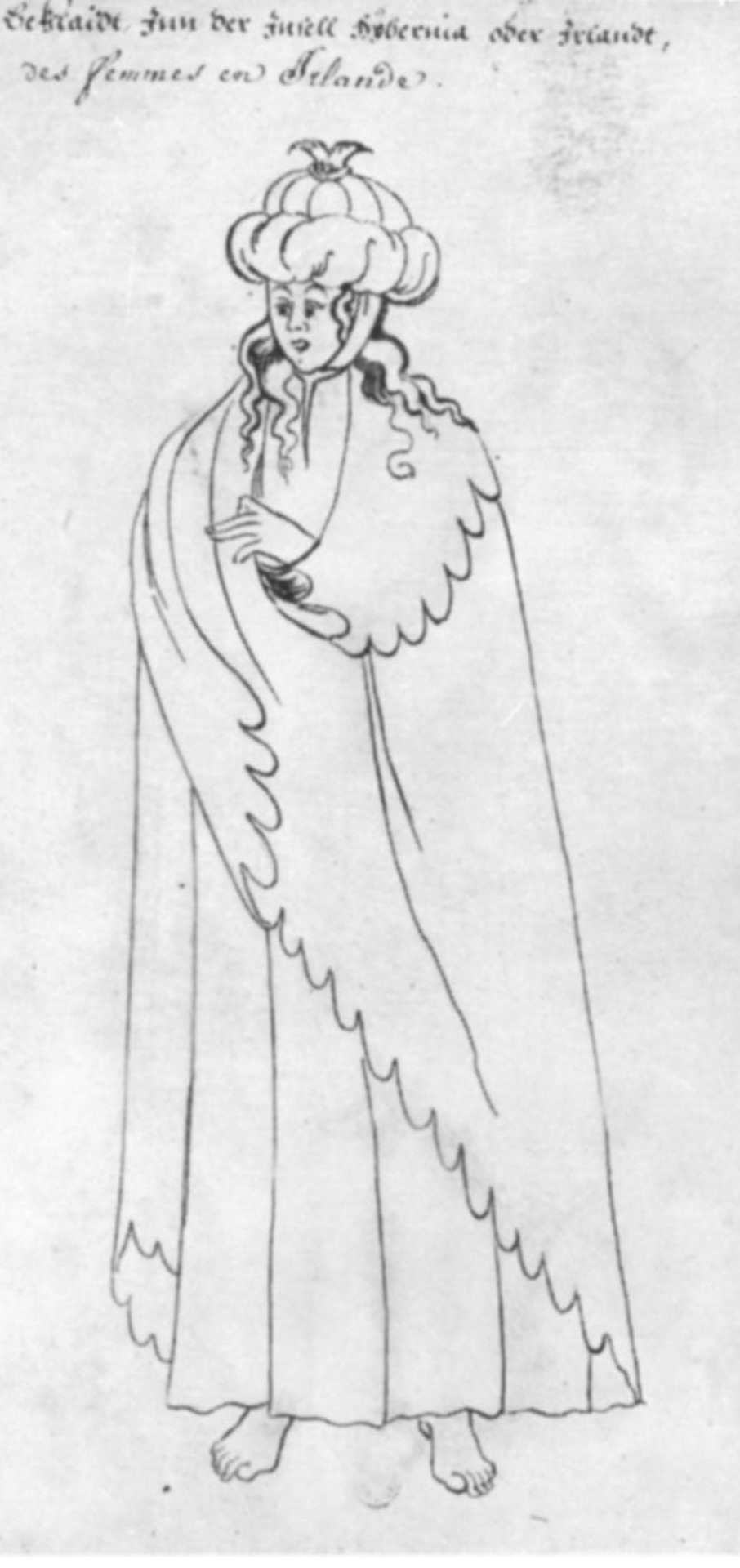

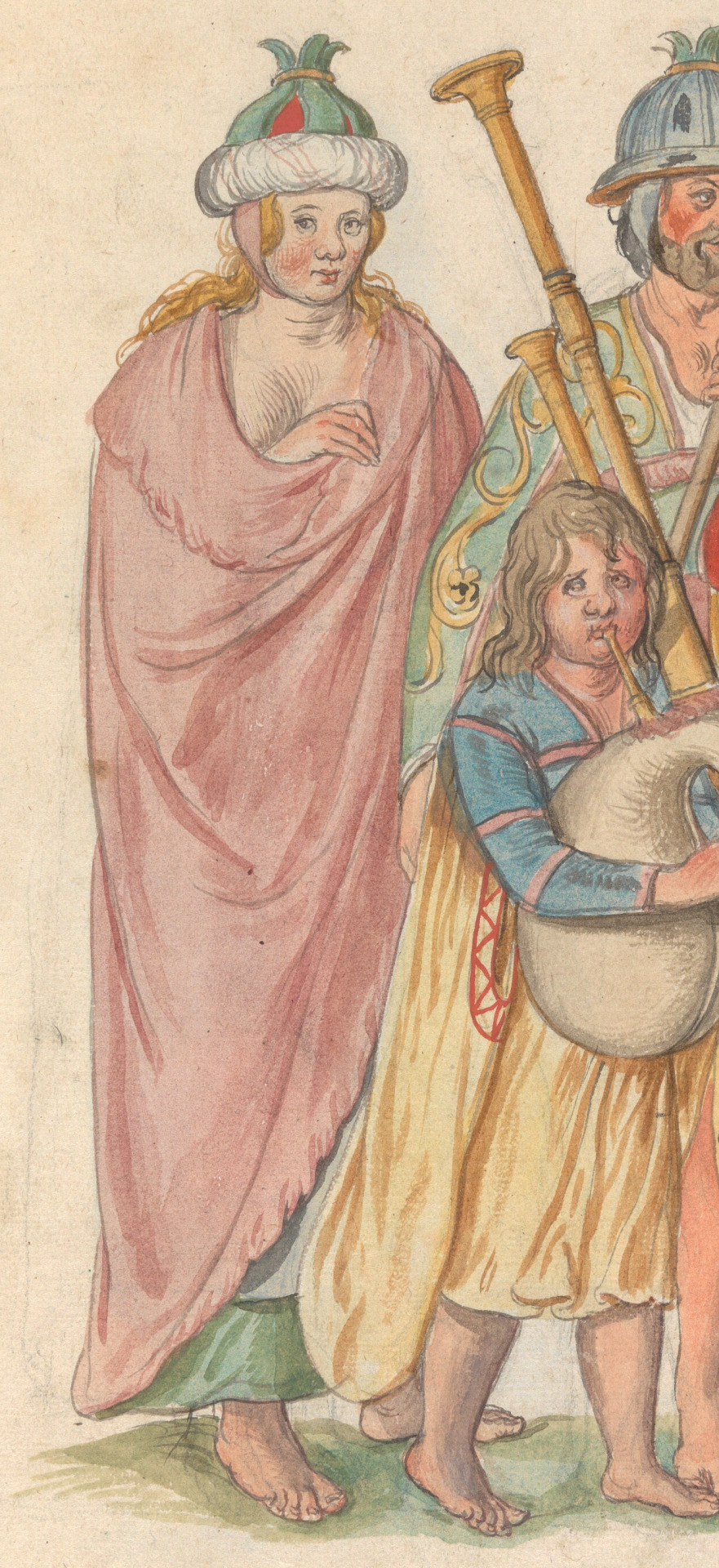

The second knockoff is the most famous. It comes from Lucas De Heere's illustration which purportedly shows Irish people in service to King Henry VIII. This is some thing De Heere couldn't have actually seen, as he moved to England 20 years after Henry VIII died and never went to Ireland at all. De Heere took the most liberties with his version. His Irish woman appears to be topless under her brat. The bottom of her léine has much less volume than the original, and De Heere has added an apron. For the hat, De Heere has replaced the crest with triangles of green wool.
Unlike De Heere's version, the final version is mostly loyal to the cut shown in the original, but it makes some unlikely suggestions for the materials. The léine appears to be green silk brocade. The brat also appears to be silk. Accounts from people who actually went to Ireland in the 16th and early 17th centuries state that these garments were made of linen and wool, respectively. Both the hat and its crest are now completely made of linen.
Chronological distortion:
The heavy use of copying in costume books also has the potential to mislead us in terms of when these fashions were worn, because the original images may be significantly older than publication year of the books that copy them. For example, the dress of Livonian women shown in Hans Weigel's 1577 book was almost certainly copied from Albrecht Dürer's 1521 watercolors. Weigel used references that were more than half a century old, but described them as if they were contemporary fashion in 1577.
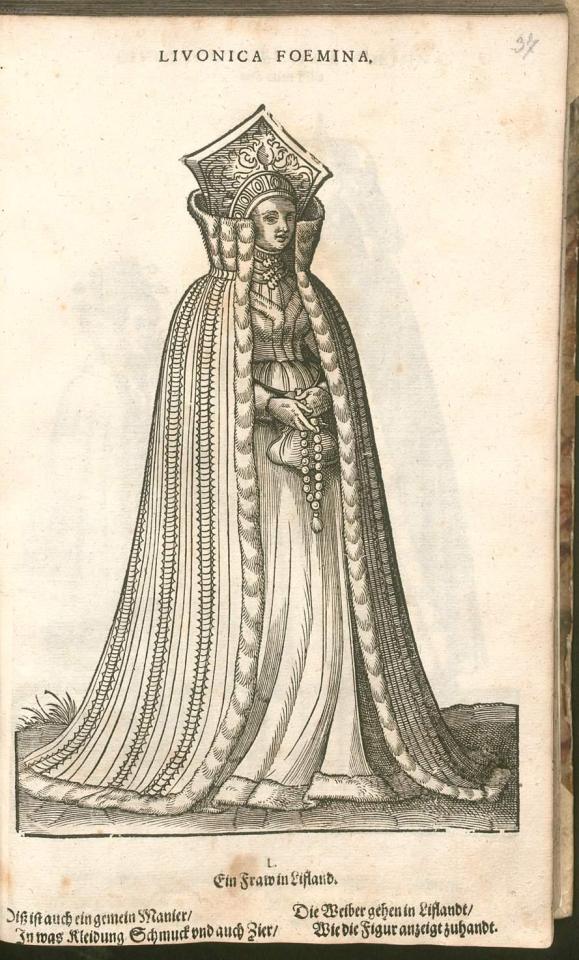
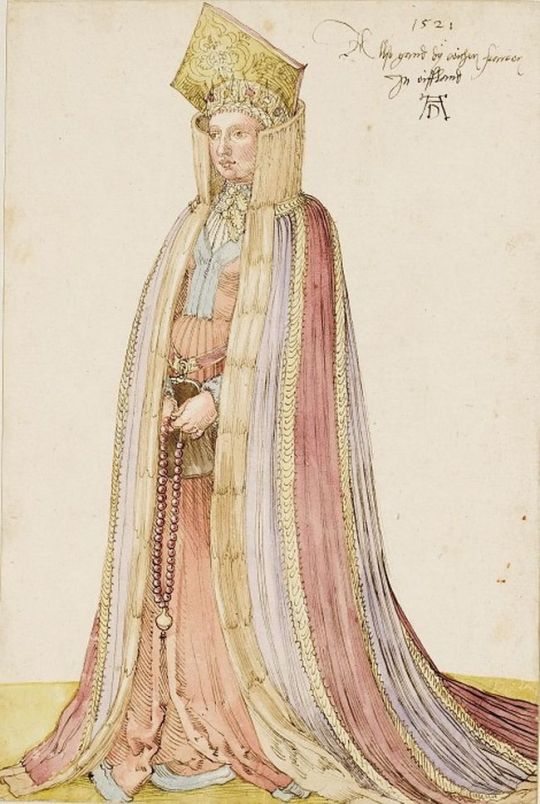
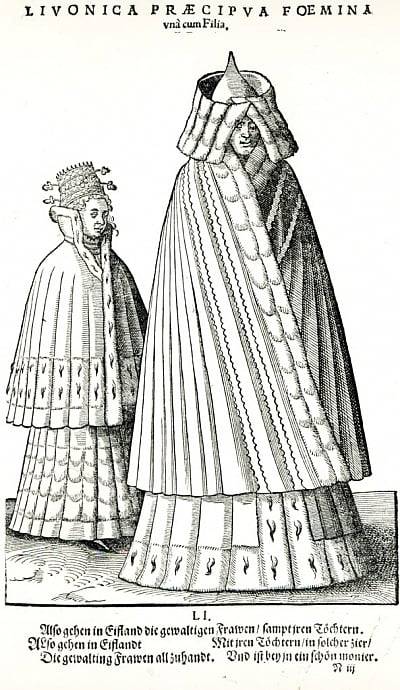
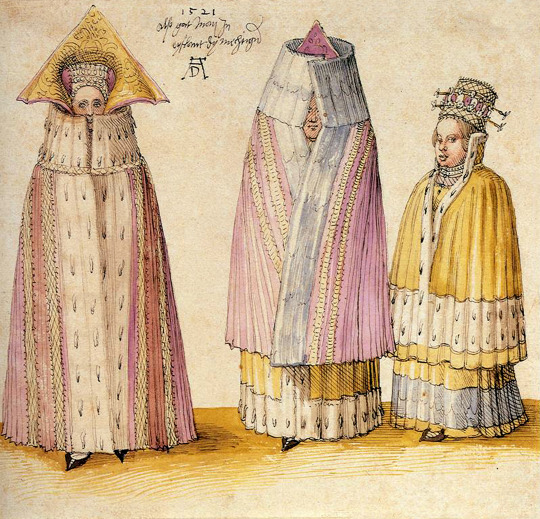
Even when costume book images are accurate portrayals of their source material, many of them lack the detail needed to identify seams, fabric types, or garment understructures. How do we deal with these problems when attempting to reconstruct what the people shown in these books actually wore?
What do we do about it?
I am not saying that we should discard these things completely as sources. Dress historians as respected as Patterns of Fashion author Janet Arnold and The Tudor Tailor authors Jane Malcolm and Ninya Mikhaila have used costume book illustrations. I definitely know less about 16th c. dress history than Jane and Ninya. I am just saying we shouldn't use them uncritically.
First, do some research on the costume book you're looking at. When was it created? Do the illustrations look suspiciously similar to those in other books? (Google image search and pinterest can be helpful for identifying this.) Did the creator, like Hans Weigel, have a particular bias they were advancing? Did they actually visit the cultures they portrayed? Christoph Weiditz actually traveled quite a bit, but he did not visit the British Isles, so his Irish and English women are probably based on someone else's art (Bond 2018). A lot of the scholarly publications about costume books are frustratingly paywalled, but some of them can be accessed for free via researchgate or academia.edu.
Avoid using copies when possible, even if the copies are more realistic-looking or more detailed art. As I discussed in the examples above, artists change things when they copy. Publication dates of copies can also be misleading in terms of dating clothing styles.
Find other sources such as: written descriptions from the time period, extant historical garments, more detailed art depicting similar fashions in related cultures, and art made by people from the culture you are studying. Period written descriptions can yield information about materials used, colors, and other details. Extant garments are your best source for information on cut and construction (unless you are lucky enough to have an extant tailor's manual from your period and culture). Detailed art depicting similar fashions can offer suggestions to fill in for missing information on construction, materials, and embellishments. Art created by the culture is valuable for identifying inaccuracies created by bigoted or ignorant artists.
Finally, remember that it's okay to not know everything. There are gaps in our knowledge about what people wore 500 years ago that will probably never be filled without a time machine. Sometimes you just have to make a plausible guess and move on. Don't let yourself get so paralyzed by doing research that you never complete the garment reconstruction/art/tumblr post you were doing the research for.
Bibliography:
Bond, K. L. (2018). Costume Albums in Charles V’s Habsburg Empire (1528-1549). https://doi.org/10.17863/CAM.25054
Dunlevy, Mairead (1989). Dress in Ireland. B. T. Batsford LTD, London.
Ilg, Ulrike. (2004). The Cultural Significance of Costume Books Sixteenth-Century Europe. In Catherine Richardson (ed.), Clothing Culture, 1350-1650 (p. 29-47). Ashgate.
McClintock, H. F. (1943). Old Irish and Highland Dress. Dundalgan Press, Dundalk.
McClintock, H. F. (1953). Some Hitherto Unpublished Pictures of Sixteenth Century Irish People, and the Costumes Appearing in Them. The Journal of the Royal Society of Antiquaries of Ireland, 83(2), 150-155. https://www.jstor.org/stable/25510871
Costume Books mentioned:
Amman, Jost. Gynaeceum, sive Theatrum mulierum.
The Costume Album of Christoph von Sternsee. not available on-line. Katherine Bond's research is your best source for this one.
Desprez, François. Recueil de la diversité des habits.
De Heere, Lucas. Corte Beschryvinghe van Engheland, Schotland, ende Irland.
Théâtre de tous les peuples et nations de la terre avec leurs habits et ornemens divers, tant anciens que modernes, diligemment depeints au naturel par Luc Dheere peintre et sculpteur Gantois.
Vecellio, Cesare, and Gratilianus, Sulstatius. Habiti antichi et moderni di tutto il Mondo di Cesare Vecellio.
Trachtenbuch des Christoph Weiditz
Weigel, Hans, and Amman, Jost. Habitus praecipuorum populorum, tam virorum quam foeminarum singulari arte depicti.
Kostüme der Männer und Frauen in Augsburg und Nürnberg, Deutschland, Europa, Orient und Afrika
Kostüme und Sittenbilder des 16. Jahrhunderts aus West- und Osteuropa, Orient, der Neuen Welt und Afrika
costume prints by an unknown artist, in the Bibliothèque nationale de France, Cabinet des Estampes. I cannot find this one online. image taken from McClintock 1953.
#dress history#historical fashion#art#16th century#17th century#historical costuming#historical dress#cw whorephobia#cw racism#irish dress#leine#irish mantle#reenactment#costume album
197 notes
·
View notes
Text
youtube
turkey
#turkish#ramen#noodle#noodles#theramenrater#the ramen rater#food#soup#hans lienesch#instant noodles#turkish series#instant#male whump#collapse#shot#whumpedit#Youtube
0 notes
Note
what animals do u see the lgts cast as
hmmmmm
elise - chihuahua, easy. a cute little guy you can carry around in your tote bag who scrounges the garbage can at ungodly hours? a spunky gremlin that yaps when they don't get their way and knows their worth? elise-coded 100%
freya - she's as fluffy as a brown bear both in terms of personality and appearance!!! i want to hug them!!! her entire vibe is just a carefree brown bear frolicking in the meadows and honestly good on her. though you know how they both look cuddly but can easily crush your bones? yeah freya your hugs are great but please watch the ribs...
lebkuchen - foxes are often associated with intelligence and mischief, which is pretty much leb! if it weren't for her strong sense of duty she'd be such a menace. and the way they hunt reminds me of her: very patient, knows exactly what you're up to, and just waiting to pounce
rozenmarine - ok hear me out tarsiers!! they're small (really small) nocturnal fluffballs that like to chill on treetops during the day. they're pretty hard to spot because of that. they have these really big round eyes and it just feels like they're always so curious about the world, like rozen!! also they can be slightly unnerving when they stare straight at you and well. rozen certainly has had her unsettling moments
muffy - raccoon. need i say more.
gustav - grizzly bear; basically a bigger, fluffier freya. they both have the protective parent vibes, pretty scary when you piss them off. otherwise pretty chill. also gustav's just a really hairy guy so
father hans - probably a lion just to subvert their association. a self-righteous clergyman who acts as kieferberg's moral compass in the most ironic way possible, but make him a "noble" lion
welma - the laziest turkish angora cat ever. don't let that laziness fool you though, she and leb are a terrifyingly effective gossip mill when you combine leb's perceptiveness and welma's charms
#little goody two shoes#lgts#i just realized i associate all of the girls except for freya with small animals#imagine taking a group pic with them and there's just this fluffy giant in the back#oooh what if they actually did have that sleepover and they all fell asleep on freya that'd be cute
22 notes
·
View notes